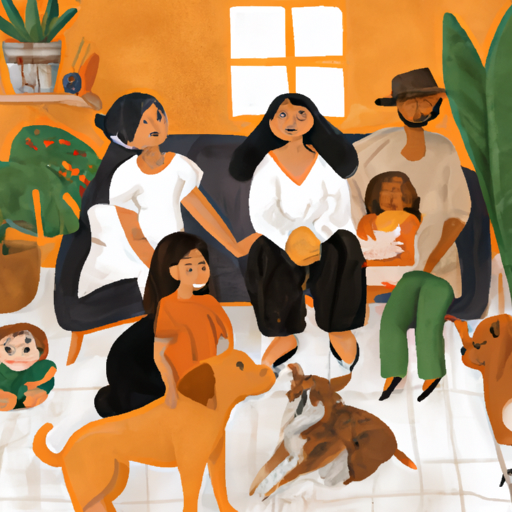You’ve probably heard the saying, ‘a dog is man’s best friend.’
But did you know that dogs are also fantastic companions for families?
In fact, a recent survey found that 63.4% of American households own a dog.
The right canine companion can bring endless joy and create lifelong memories as they become an integral part of your family unit.
However, with so many breeds to choose from, how do you determine which one will be the perfect fit for your household?
In this article, we’ll explore various family-friendly dog breeds that cater to different lifestyles and needs, ensuring that both you and your furry friend enjoy the best possible experience together.
We’ll also discuss essential factors such as preparing your home for a new pet and providing proper training and socialization.
By following these guidelines, you’ll not only foster a strong bond with your canine companion but also create cherished memories that will last a lifetime.
So, get ready to embark on an exciting journey towards finding the perfect breed for your family!
Assessing Your Family’s Lifestyle and Needs
It’s crucial to assess your family’s lifestyle and needs when choosing the perfect canine companion, ensuring a harmonious bond for years to come.
Lifestyle adjustments are par for the course when introducing a new dog into your home, but by selecting a breed that aligns with your daily routines and preferences, you’ll be setting both yourselves and your new furry friend up for success.
Consider factors such as exercise requirements, grooming needs, temperament, and size to ensure your chosen breed will seamlessly fit in with your existing way of life.
Needs consideration plays an essential role in selecting the right dog breed as well.
Think about how much time you can commit to training and socializing your pup; some breeds require more guidance than others.
Additionally, consider any allergies or sensitivities within your household – hypoallergenic breeds like Poodles or Bichon Frises might be more suitable in these cases.
Lastly, think about any future changes in your family dynamics; if you’re planning on having children or moving to a smaller living space down the line, it’s important to choose a breed that will adapt well to those evolving circumstances.
By taking all these factors into account during the selection process, you’ll create lifelong memories with the perfect canine companion who truly complements your family’s unique lifestyle and needs.
Top Picks for Family-Friendly Dogs
You might be surprised to learn that 63.4% of American families own a pet, so choosing the right family-friendly pup is more important than ever!
When selecting the perfect canine companion for your household, it’s essential to consider breed characteristics and allergy considerations to ensure a harmonious fit with your family’s lifestyle.
There are countless breeds out there, each with unique traits and temperaments. To help you narrow down your search for the ideal family dog, here are five top picks known for their friendly disposition, adaptability, and low-allergen qualities:
-
Golden Retriever: This popular breed is affectionate, intelligent, and eager-to-please – making them excellent companions for families with children. They have moderate shedding but can be groomed regularly to minimize allergens.
-
Labrador Retriever: Similar to Golden Retrievers in temperament and intelligence, Labradors are also great with kids and other pets. While they do shed seasonally, regular grooming can help keep allergies at bay.
-
Poodle: Known for their hypoallergenic coats (which require regular grooming), Poodles come in various sizes suitable for any household. Highly intelligent and trainable, they make fantastic companions for families seeking an allergy-friendly option.
-
Cavalier King Charles Spaniel: These small dogs are gentle-natured and get along well with children of all ages. They require regular grooming due to their long hair but produce fewer allergens compared to many other breeds.
-
Bichon Frise: With a curly coat similar to that of a Poodle’s (and requiring similar grooming efforts), Bichons are another hypoallergenic option perfect for households concerned about allergies. Their friendly demeanor makes them wonderful playmates for young children.
Remember that every dog has its personality regardless of breed; spend time getting acquainted before bringing home your new furry family member!
Preparing Your Home for Your New Pet
As you eagerly anticipate your new pet’s arrival, imagine transforming your home into a warm and welcoming sanctuary, designed to nurture the bond between your family and their newest member.
Pet proofing strategies are crucial in ensuring that both your dog and household belongings remain safe and intact. Depending on the breed of dog you choose, certain measures may be more important than others.
For example, if you’ve chosen an energetic breed like a Labrador Retriever or Golden Retriever, it’s essential to secure any loose wires or cords around the house as these dogs tend to be curious chewers. On the other hand, if your new pup is going to be a small breed like a Pug or Shih Tzu, make sure items that can easily topple over are either removed or placed out of reach.
Allergy considerations are another vital aspect when preparing for your new canine companion. Some breeds like Poodles and Bichon Frises produce less dander and are often considered hypoallergenic – making them suitable choices for families with allergy sufferers. However, keep in mind that no dog is 100% allergen-free; therefore, create an environment where allergens can be minimized by investing in air purifiers or keeping specific areas of the home pet-free zones.
Regular grooming will also help reduce shedding and dander buildup in your home. By addressing these factors while preparing for your perfect canine companion’s arrival, you’re setting the stage for creating lifelong memories with them as they become part of your family’s story.
Training and Socialization Tips
Proper training and socialization can’t be stressed enough when it comes to ensuring a happy, well-adjusted pup becomes an integral part of your family’s life. Different breeds have unique needs and ways they learn best, so you’ll want to consider this when planning your training strategy. Positive reinforcement is a proven method for most breeds, as it encourages desirable behaviors through rewards such as treats, praise, or playtime. Puppy playdates are also invaluable in teaching your pup how to interact with other dogs and people in a positive manner.
To help you understand the training needs of different breeds, here’s a table highlighting three popular dog breeds and their specific training requirements:
| Breed | Training Tip | Emotional Benefit |
|---|---|---|
| Labrador Retriever | Use food-based rewards for motivation | Strengthens bond between owner and pet |
| German Shepherd | Consistent leadership and mental stimulation | Builds trust; creates well-behaved companion |
| Golden Retriever | Incorporate games into training sessions | Enhances joy experienced by both pet & owner |
By catering your training approach to the breed-specific needs of your new canine companion, you’ll not only create lifelong memories but also foster strong emotional connections within your household. Remember that patience is key during this process; taking time to understand what works best for your dog will result in successful outcomes for everyone involved.
Fostering a Strong Bond with Your Furry Friend
Cultivating a deep connection with your furry pal is essential for a harmonious, loving relationship between pet and owner. Bonding activities play a crucial role in fostering this strong bond, as they provide an opportunity to understand your dog’s unique personality and needs.
Different breeds may enjoy different activities – for example, retrievers often love playing fetch, while terriers might prefer digging games. It’s important to find the type of activity that suits your specific dog breed and engage in these activities regularly. This will not only strengthen the bond between you, but also ensure that your four-legged companion stays mentally stimulated and happy.
In addition to bonding activities, understanding canine communication is pivotal when it comes to building a solid foundation with your dog. Pay close attention to their body language, vocalizations, and overall behavior patterns to better comprehend what they’re trying to convey.
Each breed has its distinct way of communicating; hounds may howl when excited or want something while herding dogs might use more eye contact and body movements. By being receptive to these subtle cues from your dog, you’ll be able to meet their needs effectively and create an environment where trust can flourish – ultimately leading towards a lifetime of cherished memories with your perfect canine companion.
Frequently Asked Questions
What are some uncommon or unique dog breeds that make great family pets which weren’t mentioned in the article?
Consider the unusual breed benefits of a Finnish Lapphund or an Otterhound. When exploring rare breed considerations, don’t overlook the Xoloitzcuintli or the Leonberger – all unique, loyal, and family-friendly canines.
How can families with allergies choose the most suitable hypoallergenic dog breed for their household?
To pick the perfect, sneeze-free pooch, consider allergy friendly grooming needs and hypoallergenic exercise habits. Research breeds like Poodles, Schnauzers, or Bichon Frises for a delightful, sniffle-proof companion.
Are there any specific dog breeds that are better suited for families with young children or elderly members?
Absolutely! For families with young children, consider breeds with child-friendly training like Golden Retrievers or Labradors. Elderly members can benefit from senior dogs like Cavalier King Charles Spaniels or Poodles.
How can one manage the transition of introducing a new dog to a household with existing pets?
Integrating pets smoothly requires understanding canine hierarchy dynamics. To ease the transition, introduce your new dog to existing pets gradually, supervise interactions, and establish separate spaces for each pet initially.
What are some ways to involve the whole family in the care and responsibilities of owning a dog, so everyone feels connected to the new pet?
Involve everyone in family bonding activities like daily walks, playtime, and grooming. Teach each member dog training techniques to build their bond with the pet while ensuring consistent behavior expectations.
Conclusion
In conclusion, finding the perfect canine companion for your family is like piecing together a jigsaw puzzle – you need to consider your lifestyle, needs, and preferences. Don’t fret; with a little research and preparation, you’ll be well on your way to creating lifelong memories with your new furry best friend.
Remember that training, socialization, and fostering a strong bond are vital for any breed. So, get ready to welcome not just a pet but an invaluable addition to your family!



